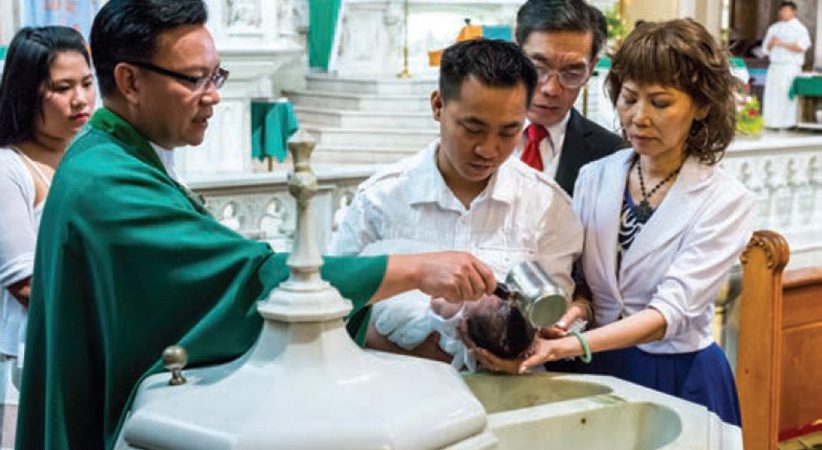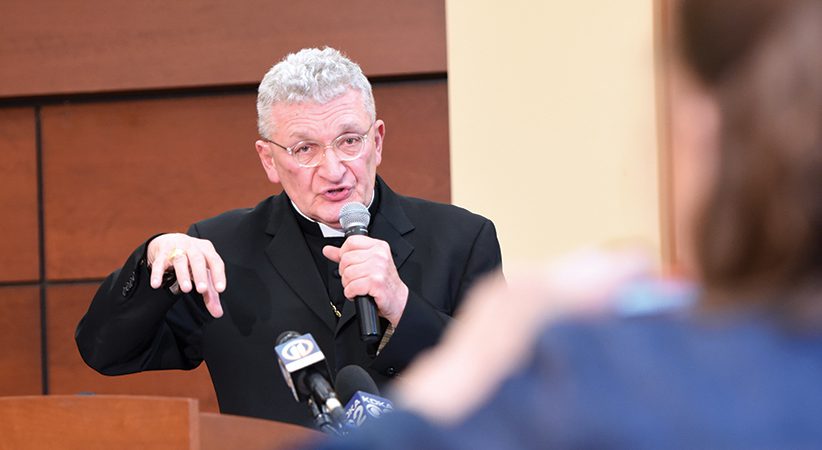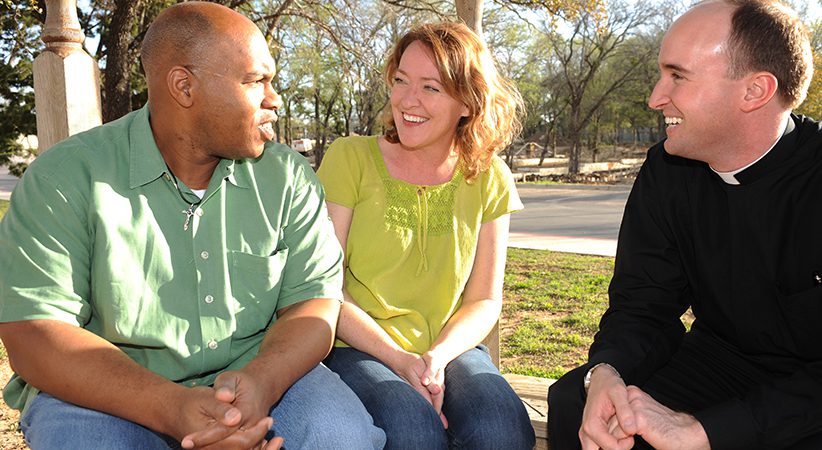A Look at the Revised Order of Baptism of Children
The new translation must be used by April 12
Father Paul Turner Comments Off on A Look at the Revised Order of Baptism of Children
Before you baptize that next infant, be sure you are using the right book. In early 2020, the revised English translation of the Order of Baptism of Children (OBC) for the United States of America was released.
You may now use the new order, and you must use it by Easter Sunday, April 12, at the latest. From that date on the former translation is being retired. If you don’t have the new book, run — do not walk — to your computer, phone, religious goods store or reliable secretary and get one right away. You will need it. Do it now. Even before reading the rest of my article.
Happily, the new book will look familiar. It is organized like the previous one, and the structure of the baptismal ceremony repeats the version you know well. This is simply a new translation of the same Latin edition you have already been using. It has a few new pieces, but nothing alarming.
Here are four ways to examine the new book: reviewing some old material you may have overlooked, noting some new items, analyzing some revised translations and planning some enhancements to your presiding.
Old and Overlooked
Newborns are to be presented for baptism within the first few weeks after birth (cf. Canon 867.1). When this entered canon law, it probably felt lax. I, for one, was baptized three days after I was born. My parents could tell I needed all the spiritual help I could get. Seriously, Catholic parents of the past felt pressured to arrange the baptism of their children even before the mother was strong enough to participate in the ceremony. The law poses less urgency. It wants her there.
However, many parents are waiting far beyond the first few weeks. Some of them take months, even years before arranging the baptism. From time to time, you may remind Catholics to share this sacrament with children as soon as reasonably possible.
Unbaptized children of catechetical age — or about the age of first Communion — are to be accepted into the order of catechumens. They will celebrate all three sacraments of initiation together, usually at the Easter Vigil, even if they are younger than the diocesan age for confirmation. The Code of Canon Law requires a priest to confirm even child catechumens whom he baptizes because of the benefit to the child (cf. Canons 883.2 and 885.2).
There is no change to the eligibility for serving as a godparent (review Canon 874 for the rules). Some parents want as godparents Catholics who are ineligible because they have never been confirmed. Some priests deny the inclusion of godparents legitimately chosen. If in doubt, consult your diocesan offices.
Deacons may preside at baptisms. However, the law does not explicitly say that they may do so during a Mass. At times — when the deacon is the grandfather of the child, has prepared the parents for this baptism, or speaks a language that the priest does not — it may seem proper for the deacon to administer the sacrament. If this is to take place during Mass, secure permission from the bishop first, just to make sure that all is in proper order.
Music is integral to the ceremony, but few parishes provide it at baptisms outside of Mass. The Order of Baptism of Children offers nine opportunities for music. Isn’t there a musician who would help?
New and Noteworthy
Adaptations pertaining to the United States are all collected now in OBC (No. 24). These will not seem very new to you. What is new is their appearance in one place. However, the fourth point is new: The anointing with chrism is never to be omitted. In the past, you could omit chrism when baptizing a large number of children. But that part of the book imagines missionary situations where one priest may be baptizing dozens if not hundreds of infants at one time. Those circumstances generally do not exist in the United States.
A spoken introduction to the ceremony is now scripted out in Nos. 36 and 75. This is largely an English translation of what the Spanish editions have already presented. It concludes with an encouragement to participate actively in the liturgy.
 |
|---|
|
THE ORDER OF BAPTISM
OF CHILDREN REVISED
is available from the U.S.
Conference of Catholic
Bishops at store.usccb.org.
|
You’ll notice some changes to No. 41, where you trace the cross on the child’s forehead. You used to say, “The Christian community welcomes you,” but now you say, “The Church of God welcomes you.” Pope Benedict authorized this change a few weeks before he resigned the papacy in 2013. The entire Church welcomes the child, not just the local community.
Furthermore, you no longer say, “in its name I claim you for Christ.” The revised translation stays closer to the Latin: “In her name I sign you with the Sign of the Cross of Christ our Savior.” And instead of “inviting” parents and godparents to do the same, you announce that they “will do the same.”
The complete litany of the saints appears in an appendix. In the United States we may now use it in place of the shorter one. The old book also included the complete litany, but it never told us how to use it. Now we know.
There’s also a much-praised appendix detailing how to celebrate a baptism during Mass. The old book explained this (cf. No. 29), but not so plainly. The opening paragraph of the appendix gives reasons for baptizing during Mass (No. 250): to allow more of the community to take part, and to show the relationship between baptism and Eucharist. That was in the old book, too, just in a place that was harder to find (No. 9).
Translation Insights
The revised English translation of the Roman Missal has received mixed reviews, so some people have been wary about revisions to other liturgical books. Nonetheless, these are on the way. (Full disclosure: I do some work for the main translating body, the International Commission on English in the Liturgy. When the commission meets once or twice a year, I join them to keep track of suggestions and comments.)
The revised translation of the OBC was nearly complete when Pope Francis issued his motu proprio Magnum Principium, giving episcopal conferences more authority over translations. The commission has taken to heart criticisms about the Roman Missal’s translation, and the members are trying to improve the proclamatory style of forthcoming books. Some of the fruit can be seen in the OBC.
The prayer of exorcism provides an example of gender-inclusive language. The former phrase “rescue man from the kingdom of darkness” is now “bring the human race, rescued from darkness” (No. 49).
The first translation rendered some common expressions inconsistently because of flexible rules. But now an expression like “God of power” is more recognizably translated as “Almighty God” (No. 62).
Those concerned about the length of sentences in some of the Missal’s collects will see some of the same issues here, such as in the instruction to parents and godparents at the handing on of a lighted candle (cf. No 64). However, an effort has been made to improve flow.
Many people found the former translation of the Ephphatha prayer offensive: “The Lord Jesus made … the dumb speak.” The word “dumb” has changed to “mute” (No. 65).
Almost every sentence has been revised; texts you once had memorized are gone. You’ll need to bury your nose in the book again until the revised translation becomes familiar.
Presiding Well
Do spend some time with the appendix that describes baptism during a Mass. Note these points:
You begin at the door of the church, or wherever the parents and godparents have gathered (cf. No. 257). The musicians lead the entrance chant. I ask them to sing only one verse because the procession is not moving anywhere.
You make the Sign of the Cross, but you do not say, “The Lord be with you.” The introduction that follows (No. 259) replaces the greeting. It indicates, “these or similar words.” You may improvise the introduction if you prefer.
The procession moves to the sanctuary after the signing of the child. For music, I suggest that the congregation sing more verses of the opening hymn. Then I reverence the altar and go to the chair. The penitential act is omitted.
In my parish, if the Mass includes the Gloria, we sing it as the procession moves to the sanctuary. I arrive at the chair before the Gloria concludes, in place for the collect.
If this is a Sunday Mass, you use the collect of the day. However, if it is a Sunday in Ordinary Time, you may replace the collect with one from the Ritual Mass for the Conferral of Baptism. You may even replace the readings with those proposed in the fourth volume of the Lectionary or in the OBC starting at No. 186. I do not recommend replacing readings at a parish Sunday Mass, but you may in this case. Outside Ordinary Time, you may replace only one of the assigned readings with one for baptism. I do not recommend this either, but it may be done.
After the homily, there is no creed because all will be renewing their baptismal promises with the parents and godparents (No. 282).
The baptismal ceremony begins with the universal prayer (prayer of the faithful). Almost every priest I know has been doing this differently — that is, the universal prayer follows the baptism. But No. 29 has always said that these petitions precede baptism. They lead right into the Litany of the Saints, which even at the Easter Vigil comes first.
For the blessing of water (cf. No. 279), many priests object to the length of this prayer when offered during Mass. I agree, so I usually use one of the optional water blessings, available at Nos. 223-24. These include acclamations for the people, and they are shorter. Note the special ending for baptisms during Easter time.
For the preface, the Missal’s ritual Mass makes some important suggestions: Preface II of Easter during Easter time, and Preface I of Ordinary Time for the other periods of the year. Although these are not obligatory, they beautifully draw out the meaning of baptism.
Special intercessions for the Eucharistic Prayer come from the same section of the missal. Many priests use Eucharistic Prayer 2 because it’s the shortest, and this Mass is already getting pretty long. Whichever prayer you use, include the special intercession for the newly baptized. I mark it with a ribbon, but other priests copy it and place it into the missal at the appropriate spot. If you use Eucharistic Prayer 1, you will state aloud the names of the godparents. This honor usually pertains only to the bishop and the pope.
Mass may conclude with a solemn blessing. You say, “The Lord be with you,” and the people respond as usual. The deacon says, “Bow down for the blessing.” In his absence, you say that. Give the solemn blessing in its three parts. Everyone is supposed to answer “Amen” to each part, but the response is often sluggish because people aren’t sure when each part ends. Be patient. Use the solemn blessings frequently so that everyone learns what to do.
Then you give the blessing formula. All answer, “Amen.” The deacon dismisses the people, or you do it in his absence.
FATHER PAUL TURNER is pastor of the Cathedral of the Immaculate Conception and director of the Office of Divine Worship for the Diocese of Kansas City-St. Joseph.
………………………………………………………………………………………………………………………………………………….
Helpful reminders to presiders of baptisms
BAPTISM REMINDERS:
1. The translation for the formula of baptism has not changed. Please do not change it yourself. Some priests and deacons have horrifically baptized with words they consider more trendy, such as “in the name of the Creator, the Redeemer, and the Sanctifier.” Such formulas are invalid, and they cause immense problems for the individuals you are trying to help. Use the approved formula. If it was good enough for Jesus (cf. Mt 28:19), it should be good enough for you.
2. We should all take to heart the admonition in OBC: “Whoever is conferring Baptism … should strive above all to be courteous and affable to everyone” (No. 7). People should experience coherence between the mystery you celebrate and the person you are.
…………………………………………………………………………………………………………………………………………………





